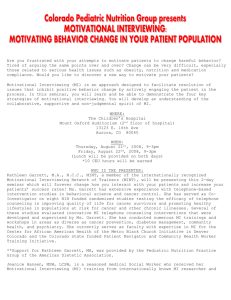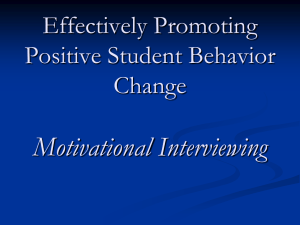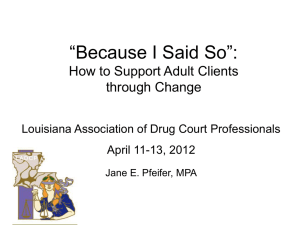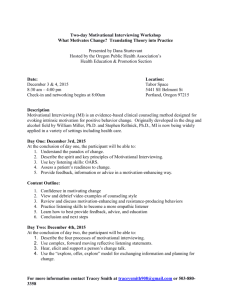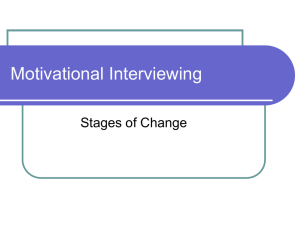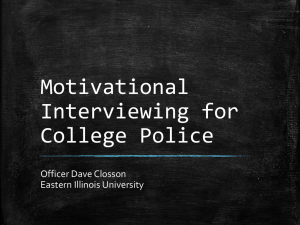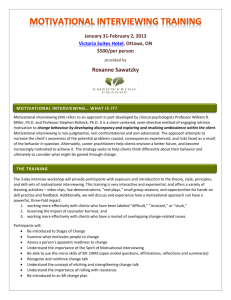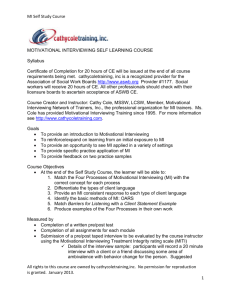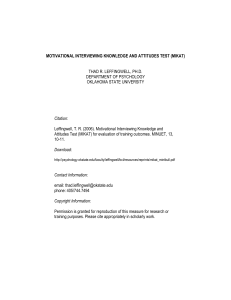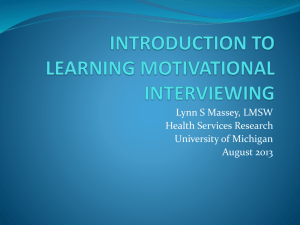5.3.11 power point presentation CVLS_Engagement
advertisement
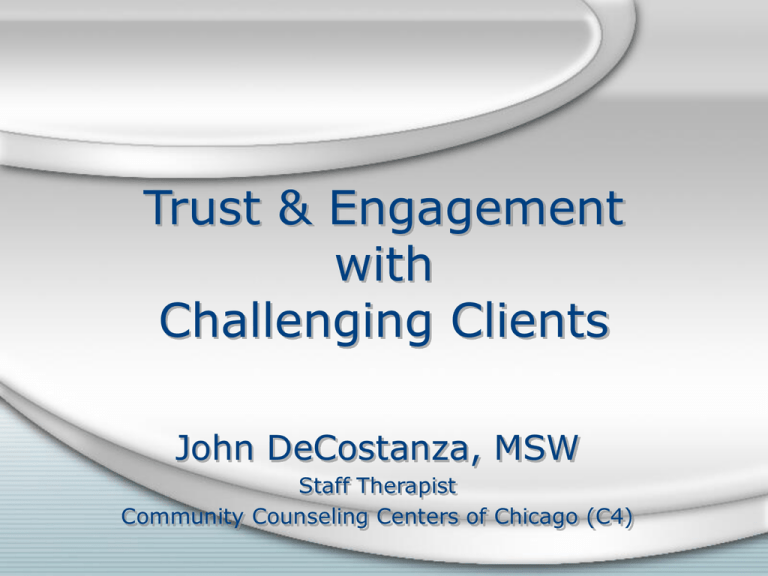
Trust & Engagement with Challenging Clients John DeCostanza, MSW Staff Therapist Community Counseling Centers of Chicago (C4) Why Engagement? • Objective Focused – Obtaining Facts • Thorough history • Presenting Problem • Risk and Resilience Factors • Establishing Relationship – Trust • Antecedent for rest of your work What is Engagement? • Interactional, interpersonal process that begins at time of first contact with an agreement to work together (Compton & Galway, 1994) • Clinical outcome in the literature (Litell, Alexander, & Reynolds, 2001) • “dynamic, complex, multilevel phenomenon” or “positive involvement in the helping process” (Yatchmenoff, 2005) What is Engagement? SEVEN THEMES 1. 2. 3. 4. 5. 6. 7. Common & clear goals together Sense of hopefulness Awareness, acknowledgement, and understanding of situations accurately (by all parties) Consistent motivation Need for workers (attorneys) to identify, understand, and respect cultural differences Truth, honesty, and respect Persistence, diligence, and timely work done by all (Cooper Altman, 2008) Who? Your Ct Population Barriers to Engagement Many families come…because a crisis has forced the issue, or an agency or court has mandated it. Motivation is uneven… They show up irregularly, mostly when new crises erupt. In sessions, they have trouble presenting their stories coherently. They seem in disarray as they talk over one another or talk hardly at all. Some have described these families as disorganized; I prefer the term underorganized. Underorganization suggests not so much an improper or randomly chaotic organization as a lack of organization, a structure that has not fully developed. These structures have not achieved the constancy, differentiations, and flexibility they need to meet the demands of life. Harry Aponte, Bread and Spirit: Therapy with the New Poor: Diversity of Race,Culture, & Values, 1994 p. 17 Barriers to Engagement • Multiple needs – Trauma hx, violence – Other legal involvement, family hx • Limited effective coping skills • Maladaptive patterns • Internalizing Disorders – Low motivation, poor self-narrative, high levels of relational conflict, fear, anxiety, sadness, hopelessness • Externalizing Disorders – All of the above PLUS impulsivity, outwardly directed anger (aggression), running, etc. • CULTURE, CULTURE, CULTURE First Contact • The Antecedents – Office set-up; Behavior in the waiting room; Snacks or candy; Documents at the ready; YOU, YOU, & YOU • The Tool(s) – GAL Cases Background Info Form – Confidentiality (e.g. - Adolescents) • The Interview – Narrative is a portrait of cognitive process, mental state, and risk factors. • The Skills – Necessary to integrate each of the above and utilize ct’s language to clearly echo back the problem. Challenging Clients & Motivational Interviewing Motivational Interviewing Definition: A collaborative, personcentered form of guiding to elicit and strengthen motivation for change. Highlights: interpersonal; client is the locus of change & motivation; purpose is CHANGE Challenging Clients & Motivational Interviewing • Guiding Skills - OARS – Open-ended questions – Affirmations – Reflections • Double-sided reflections with adolescents – Highlight ambiguity: “On the one hand… on the other” • Intensity - reflecting emotions requires precision “a little sad” vs. “totally depressed” • Metaphors & Similies - always best if they come from the client, but occasionally you’ll be able to paint the picture. • Drop the stem - particularly avoid naming feelings “It seems like what you are feeling is…” – Summaries Challenging Clients & Motivational Interviewing RESISTANCE: A battle of counter-intuition STOP: Don’t push back or move further DROP (back…tone it down): Monitor your own behavior (this is about you not the client). ROLL: Come alongside the client Challenging Clients & Motivational Interviewing Responding to RESISTANCE: STOP Teen: “Why aren’t you letting me go home with Diamond?” DROP & ROLL GAL: “I’m not. This is a result of your decision to live with her in the first place.” Emphasizes personal control. GAL: “Well, what makes you think that I don’t want you to go home with Diamond?” Redoubling GAL: “You want me to place with you with Diamond.” Reflection Challenging Clients & Motivational Interviewing • Strategic responses – Emphasize personal choice and control (ALWAYS) – Pros and Cons (simple lists are powerful tools) – Agreement with a Twist (“I wonder”) Teen: Everything about school is boring. I don’t learn anything, and I don’t know why I go. Me: It sounds like you get bored in school every day. I wonder if there’s some way that we can make classes more interesting for you. Challenging Clients & Motivational Interviewing • Strategic responses continued – Shifting Focus • Teen: I don’t want to live with Maritza, and I know that’s what you are going to tell the judge. • GAL: Hold on a minute. I don’t even know the whole story and I especially don’t know all of what you’re going to say. Why don’t you tell me more about your living situation right now? Recommendations 1. Time is what you have and it’s always well spent on children. (Process) 2. Take your shoes off because the ground that you stand on is often sacred. (Culture) 3. Motivation + Engagement = CHANGE 4. When in doubt, go slow, and reflect. 5. Utilize consultation - talk to your CVLS staff attorneys; consult with other professionals who have been working with your clients longer than you. Service Flow for ADHD • Manifestation of 1st Symptoms – Age 3; Not really diagnosable until 5-7 years • ID – Parent – Teacher – Administrative Apparatus (rarely SSW or Special Ed Services) Service Flow for ADHD • CPS Levels of Care – Tier I - Universal Supports • Little $, Support • Reinforces Natural Supports • Eg. Prevention Programs – Tier II - Targeted Support • Children with specific needs who can be pulled out and offered services to reinforce coping skills • Eg. NRI Anger-Coping & CBITS – Tier III - Individual Intervention • Referral to External Agencies for Dx, Psychiatric services, and continued support • Outpatient Tx Service Flow for ADHD • Outpatient Tx – Medical Dx – Individual, Family, & Group Modalities – Psychiatric Services • Psych Eval followed by Medication Mgmt • Psych Testing (Psychologist) – Purpose: REDUCTION of symptoms • Intensive Outpatient (IOP) (PSR “Psychosocial Rehab” for adults) – Regular attendance (multiple sessions weekly) – Separate Screening Process – Well Regimented Schedule Service Flow Cont. • Psychiatric Hospitalization – Screening Provided by SASS – Crisis Intervention – Criteria • Injury or Risk to Self or Others • Inability to Safety Plan • Sxs seem not to respond to current level of care – 90 Day Brief-Intervention then linkage – Hospitalization: Acute Care (stabilize child and return family to lower level of fx) Contact Information John DeCostanza, MDiv MSW Community Counseling Centers of Chicago (C4) 2542 W. North Ave. Chicago, IL 60647 Phone: 773.365.3003 Email: john.decostanza@c4chicago.org

